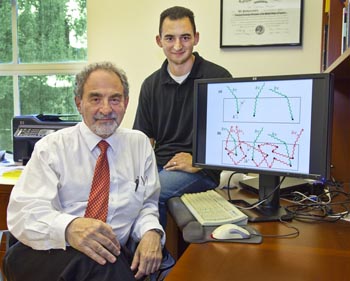
Eli Yablonovitch and Owen Miller, who worked out the theory for the new solar cell efficiency. The monitor in the picture illustrates the new physics concept where increased light emission yields higher efficiency.
In photovoltaics, as in business, good resource management leads to greater efficiency. Managing the photons within a gallium arsenide solar cell to maximize its external fluorescence was the key step to realizing its record efficiency, according to two University of California at Berkeley (U.S.A.) researchers who studied the theory behind the cell’s design.
Eli Yablonovitch and graduate student Owen Miller, both of Berkeley’s electrical engineering department, are presenting their findings this week at the CLEO: 2012 conference in San Jose, Calif.
The pair investigated why modern semiconductor solar cells still don’t come close to the absolute efficiency limits predicted by William Shockley and Hans Queisser in 1961. They studied the thermodynamic link between absorption and emission and found that, ideally, a solar cell should radiate a photon of a different wavelength for every photon it absorbs at open circuit. Gallium arsenide is much better at doing this than silicon, a traditional component of photovoltaics.
In a solar cell with optimal “light extraction,” the geometry of the material allows more photons to escape freely from the front surface of the cell, thereby generating higher voltage. A prototype single-junction cell designed by a company that Yablonovitch co-founded has demonstrated 28.4 percent efficiency, and the researchers predict that single-junction cell efficiency could exceed 30 percent in the near future.
In other news from CLEO: 2012, scientists from the University of Texas at Austin and Stanford University teamed up to design a 9.6-mm fiber-coupled probe for femtosecond laser microsurgery. Their design is significantly smaller in volume than previous designs, which will bring the tool closer to the goal of clinical use.
Also, Stefan Droste and his colleagues at the Max Planck Institute for Quantum Optics in Germany announced a signal transfer over a 920-km fiber optic link to the German Federal Institute of Physical and Technical Affairs with relative accuracy of 10-19. Such precision may help disseminate the signals from the world’s most accurate clocks, and perhaps even test concepts and quantities in fundamental physics.
